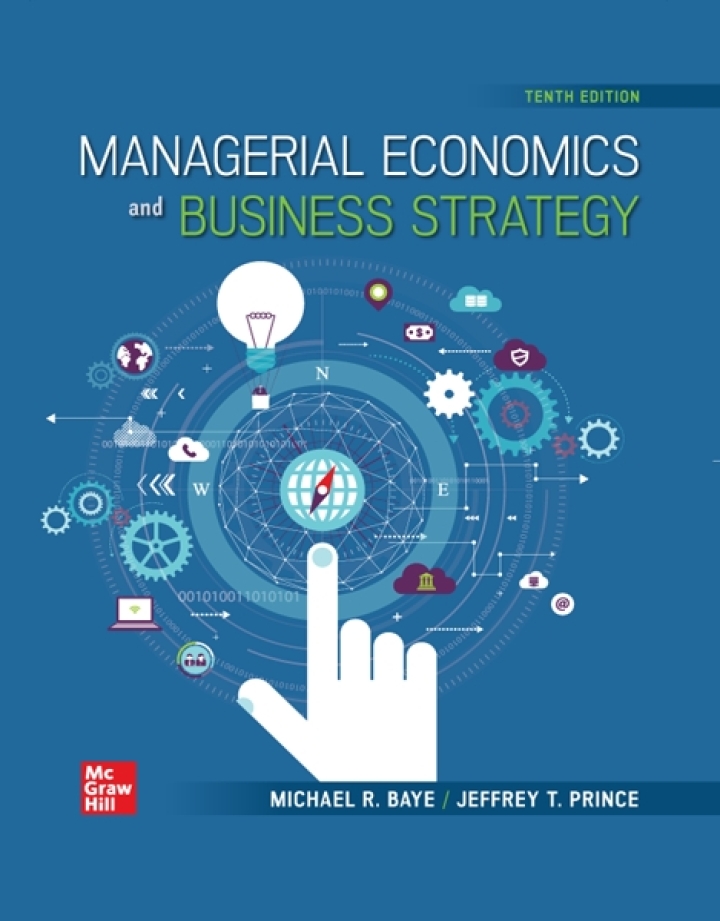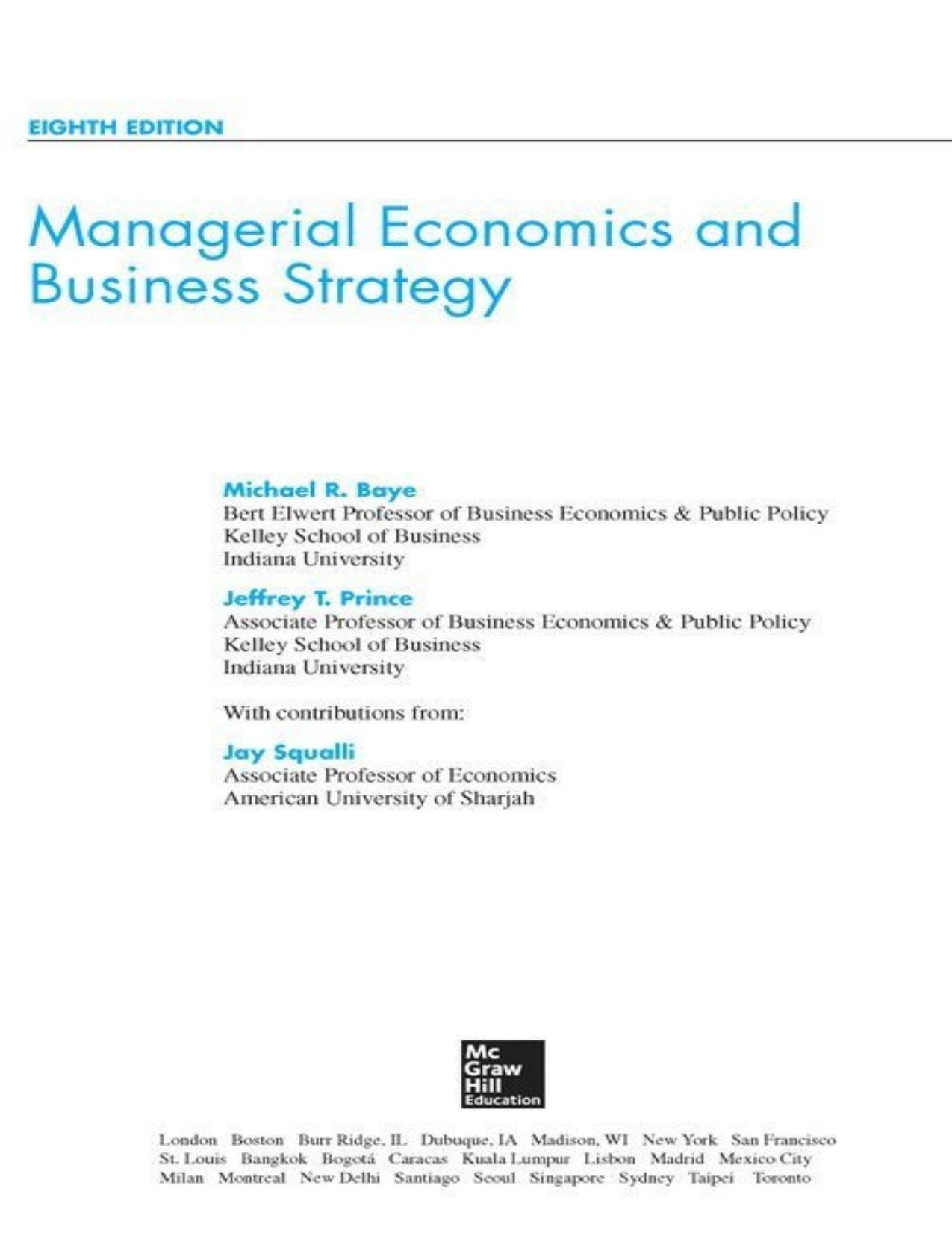Managerial Economics and Business Strategy 10th edition by Michael Baye ISBN 1264574398 9781264574391
$70.00 Original price was: $70.00.$35.00Current price is: $35.00.
Instant download Managerial Economics and Business Strategy after payment
Managerial Economics and Business Strategy 10th edition by Michael Baye – Ebook PDF Instant Download/Delivery: 1264574398, 9781264574391
Full download Managerial Economics and Business Strategy 10th edition after payment

Product details:
ISBN 10: 1264574398
ISBN 13: 9781264574391
Author: Michael Baye
Baye/Prince’s Managerial Economics and BusinessStrategyprovides students with tools from intermediate microeconomics such as game theory and industrial organization and teaches practical utility of other basic economic tools that they need to make sound managerial decisions. The 2025 Release retains its emphasis on real-world examples and modern topics with unique coverage found nowhere else. This balanced coverage of traditional and modern microeconomic tools makes it appropriate for a wide variety of managerial economics classrooms.
Managerial Economics and Business Strategy 10th Table of contents:
Chapter 1: The Fundamentals of Managerial Economics
-
Introduction: Overview of the role and importance of managerial economics in decision-making.
-
The Economics of Effective Management: Discusses how economic principles guide managerial decisions for optimizing resources and profits.
-
Learning Managerial Economics: Introduces methods and approaches for studying and applying managerial economics.
-
Key Terms and Concepts: Essential terminology and definitions in managerial economics.
-
Conceptual and Computational Questions: Questions to test understanding and application of concepts.
-
Problems and Applications: Real-world problems and applications of managerial economics.
-
Selected Readings: Further readings on the topic.
-
Appendices:
-
Appendix A: The Calculus of Maximizing Net Benefits
-
Appendix B: Evaluating the Overall Fit of the Regression Line
-
Chapter 2: Market Forces: Demand and Supply
-
Introduction: Overview of how demand and supply affect market outcomes.
-
Demand: Factors that determine demand for goods and services.
-
Supply: Factors that determine the supply of goods and services.
-
Market Equilibrium: Analysis of the point where demand and supply intersect.
-
Price Restrictions and Market Equilibrium: The impact of price floors and ceilings on equilibrium.
-
Comparative Statics: Analyzing shifts in supply and demand curves.
-
Summary: Key takeaways from the chapter.
-
Key Terms and Concepts: Definitions related to demand, supply, and market equilibrium.
-
Conceptual and Computational Questions: Questions to test understanding.
-
Problems and Applications: Practical applications of demand and supply analysis.
-
Selected Readings: Further readings on market forces.
Chapter 3: Quantitative Demand Analysis
-
Introduction: Introduction to the concept of demand elasticity.
-
The Elasticity Concept: How responsive demand is to changes in price or income.
-
Own Price Elasticity of Demand: Measurement of how demand changes with price.
-
Cross-Price Elasticity: How demand for one good changes in response to the price of another good.
-
Income Elasticity: How demand changes with income changes.
-
Other Elasticities: Additional types of elasticity (e.g., advertising elasticity).
-
Obtaining Elasticities from Demand Functions: Methods to calculate elasticity from demand functions.
-
Data-Driven Demand Curves: Using real-world data to estimate demand curves.
-
Summary: Key insights from elasticity analysis.
-
Key Terms and Concepts: Key definitions related to elasticity.
-
Conceptual and Computational Questions: Questions for understanding elasticity.
-
Problems and Applications: Practical examples of demand elasticity analysis.
-
Selected Readings: Further readings on demand analysis.
Chapter 4: The Theory of Individual Behavior
-
Introduction: Understanding individual consumer behavior in economics.
-
Consumer Behavior: The decision-making process of consumers.
-
Constraints: Budget constraints and their impact on consumer decisions.
-
Consumer Equilibrium: The point where consumers maximize utility.
-
Comparative Statics: How changes in external factors affect consumer behavior.
-
Applications of Indifference Curve Analysis: Visualizing consumer preferences and choices.
-
Relationship Between Indifference Curve Analysis and Demand Curves: Connecting consumer preferences to market demand.
-
Summary: Key takeaways from consumer behavior theory.
-
Key Terms and Concepts: Definitions related to individual behavior and utility.
-
Conceptual and Computational Questions: Questions for understanding and applying individual behavior concepts.
-
Problems and Applications: Practical exercises related to consumer behavior.
-
Selected Readings: Further readings on individual behavior and decision-making.
Chapter 5: The Production Process and Costs
-
Introduction: Overview of how firms produce goods and the costs involved.
-
The Production Function: Relationship between inputs and outputs in production.
-
The Cost Function: Understanding how production costs behave as output changes.
-
Multiple-Output Cost Functions: Analyzing cost functions for firms producing more than one product.
-
Summary: Key takeaways from production and cost analysis.
-
Key Terms and Concepts: Definitions related to production and costs.
-
Conceptual and Computational Questions: Questions to test understanding of production processes.
-
Problems and Applications: Real-world cost and production examples.
-
Selected Readings: Further readings on production and cost theory.
-
Appendix: The Calculus of Production and Costs
Chapter 6: The Organization of the Firm
-
Introduction: How firms organize and manage their operations.
-
Methods of Procuring Inputs: Different ways firms acquire the resources they need.
-
Transaction Costs: Costs associated with conducting economic exchanges.
-
Optimal Input Procurement: Efficient methods for obtaining inputs at the lowest cost.
-
Managerial Compensation and the Principal-Agent Problem: Incentives and conflicts between managers and owners.
-
Forces that Discipline Managers: Mechanisms that ensure managers act in the best interest of the firm.
-
Manager–Worker Principal–Agent Problem: Issues that arise between workers and managers.
-
Summary: Key takeaways on firm organization.
-
Key Terms and Concepts: Definitions related to firm management and economics.
-
Conceptual and Computational Questions: Questions for testing the understanding of organizational concepts.
-
Problems and Applications: Examples of real-world firm organization challenges.
-
Selected Readings: Further readings on firm organization.
-
Appendix: An Indifference Curve Approach to Managerial Incentives
Chapter 7: The Nature of Industry
-
Introduction: Overview of the industrial organization and market structures.
-
Market Structure: Classification of industries based on their characteristics (e.g., competition, number of firms).
-
Conduct: The behavior of firms within an industry.
-
Performance: How well the industry performs in terms of efficiency and profitability.
-
The Structure–Conduct–Performance Paradigm: A framework for analyzing the relationship between market structure, firm conduct, and industry performance.
-
Overview of the Remainder of the Book: Introduction to upcoming chapters.
-
Summary: Key insights on industry structure and performance.
-
Key Terms and Concepts: Definitions of industrial organization terms.
-
Conceptual and Computational Questions: Questions to assess understanding of industrial organization.
-
Problems and Applications: Applications of industrial organization theory.
-
Selected Readings: Additional resources on industrial economics.
Chapter 8: Managing in Competitive, Monopolistic, and Monopolistically Competitive Markets
-
Introduction: Overview of different market structures and strategies for managing within them.
-
Perfect Competition: Characteristics of a perfectly competitive market and firm behavior.
-
Monopoly: Analysis of monopoly market structure and pricing strategies.
-
Monopolistic Competition: Features of monopolistic competition and strategic behavior.
-
Optimal Advertising Decisions: Determining the best advertising strategy in various market conditions.
-
Summary: Key takeaways from managing in different market environments.
-
Key Terms and Concepts: Definitions related to market structures and strategies.
-
Conceptual and Computational Questions: Questions related to market structures and competitive behavior.
-
Problems and Applications: Practical examples of managing in different market conditions.
-
Selected Readings: Further readings on market structures.
-
Appendices:
-
The Calculus of Profit Maximization
-
The Algebra of Perfectly Competitive Supply Functions
-
People also search for Managerial Economics and Business Strategy 10th:
baye managerial economics and business strategy
borrow managerial economics and business strategy
managerial economics and business strategy 10th edition solutions
managerial economics and business strategy tenth edition
managerial economics and business strategy answer key
Tags:
Michael Baye,Managerial Economics,Business Strategy



